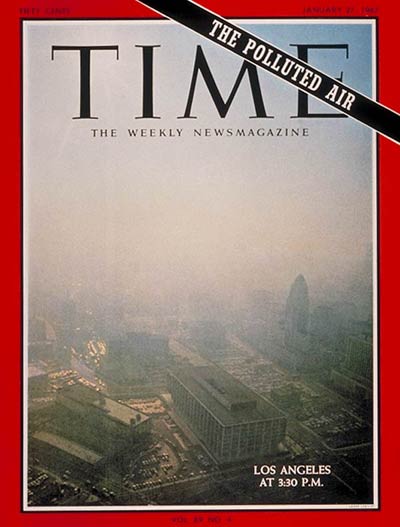
Milestone moments do not a year make. Often, it’s the smaller news stories that add up, gradually, to big history. With that in mind, in 2017 TIME History will revisit the entire year of 1967, week by week, as it was reported in the pages of TIME, to see how it all comes together. Catch up on last week’s installment here.
Illustrated with several pages of color photos, this cover story traced the growing awareness that “belching smokestacks that long symbolized prosperity” were becoming a “source of irritation,” or worse. Though air pollution wasn’t a new phenomenon, it was getting worse as consumption of power increased in the U.S. and around the world, causing “$11 billion a year in property damage alone” and numerous health problems. It was also, the magazine noted, causing a “gradual warming trend” that could “melt the polar ice craps”—a warning that may sound like something meant for today’s readers, not those of 50 years ago. (As the magazine noted, this disaster would at least solve one problem: “Since this would raise ocean levels more than 100 feet, it would effectively drown the smog problems of the world’s coastal cities.”)
What was to be done?
Frank Stead, a high-ranking California state public-health official, thought he knew. It was “clearly evident,” he told TIME, that by 1980 the gasoline engine had to be completely replaced by electric power, and that in order to get there California would have to declare that gas-powered vehicles were banned in the state after 1980. Given that prediction, then, it is perhaps less surprising that TIME struck a somewhat optimistic note about the hope of turning back the tide on pollution and climate change:
The waters, however, need never rise. Within his grasp, man has the means to prevent any such apocalyptic end. Over the short run, fuels can be used that produce far less pollutant as they burn. Chimneys can be filtered so that particulate smoke is reduced. Automobile engines and anti-exhaust devices can be made far more efficient. What is needed is recognition of the danger by the individual citizen and his government, the establishment of sound standards, and the drafting of impartial rules to govern the producers of pollution. Over the long run, the development of such relatively nonpolluting power sources as nuclear energy and electric fuel cells can help guarantee mankind the right to breathe.
Fifty years later, that optimism has proved unwarranted and some of the solutions scientists already knew about back in 1967 are still seen as cutting-edge today.
Developing story: Muhammad Ali—then 25, and still referred to as Cassius Clay despite having announced that he was giving up that name—had informed the Louisville draft board that he spent 90% of his waking hours on his religious vocation, not on fighting, and that he should be entitled to an exemption from the draft. The board disagreed, and as his lawyer filed another appeal, Ali vowed that he would take his case all the way to the Supreme Court. (He would, though not before he was temporarily stripped of his boxing license.)
Harsh words: A review of Sigmund Freud and William C. Bullit’s psychological study of Woodrow Wilson began thus: “It would be hard to find a literary collaboration more ill conceived than this one—a psychoanalytic post-mortem conducted on a U.S. President by two men who were admittedly prejudiced against their subject, and based on second-or third-hand information.”
Regrettable period detail: An article about the growing ease of adopting a child in the U.S. explained that agencies were getting rid of rules that required high incomes, childlessness and youth in prospective adoptive parents. Barriers did, however, remain: “Such states as New York and Massachusetts generally refuse to grant adoptions to couples of mixed religions, or nonbelievers.” (Another point of interest: at the time, the rate of births to unmarried women was 23.4 births per every 1,000 single women, the article noted, explaining that 80% of adopted children fell into that category. In 2014, the rate was 43.9 out of 1,000.)
Great vintage advertisement: What do you get when you combine sports equipment and meat?
Coming up next week: Astronauts
More Must-Reads from TIME
- Donald Trump Is TIME's 2024 Person of the Year
- Why We Chose Trump as Person of the Year
- Is Intermittent Fasting Good or Bad for You?
- The 100 Must-Read Books of 2024
- The 20 Best Christmas TV Episodes
- Column: If Optimism Feels Ridiculous Now, Try Hope
- The Future of Climate Action Is Trade Policy
- Merle Bombardieri Is Helping People Make the Baby Decision
Write to Lily Rothman at lily.rothman@time.com